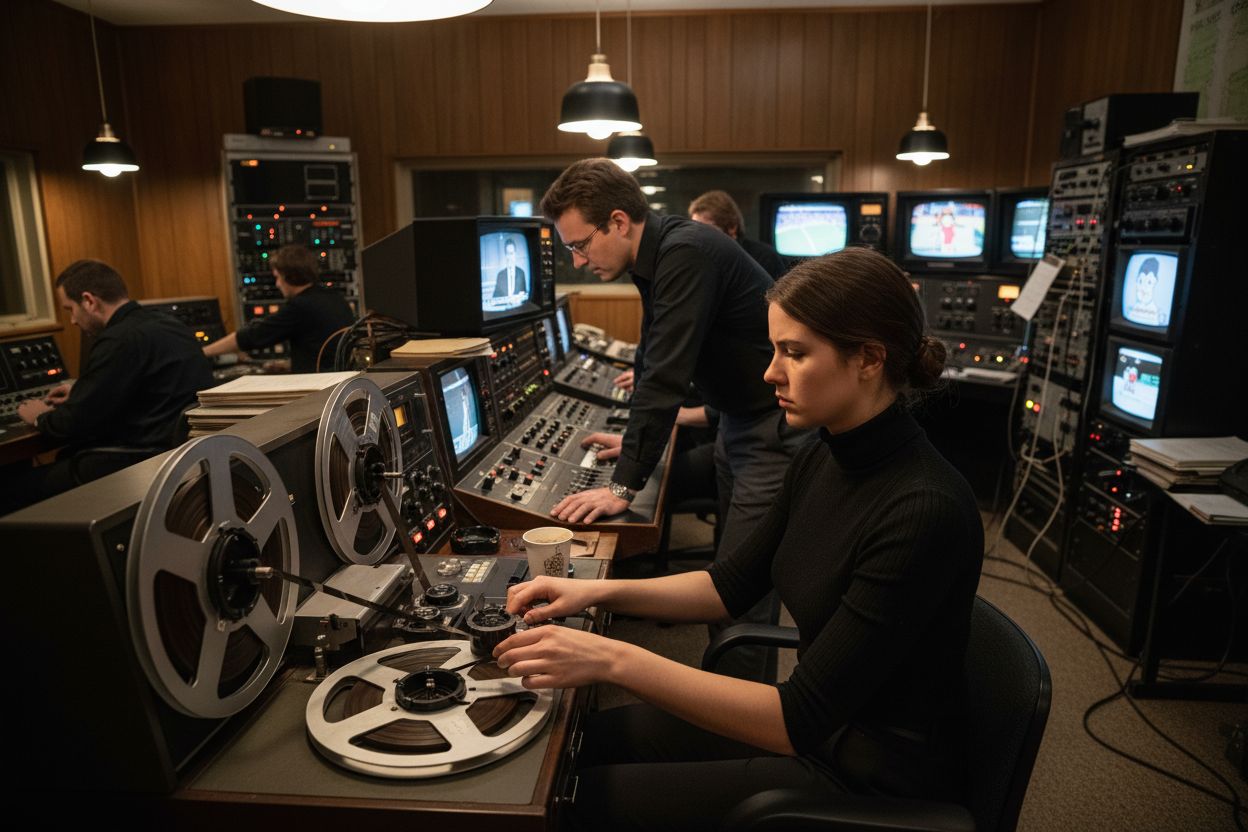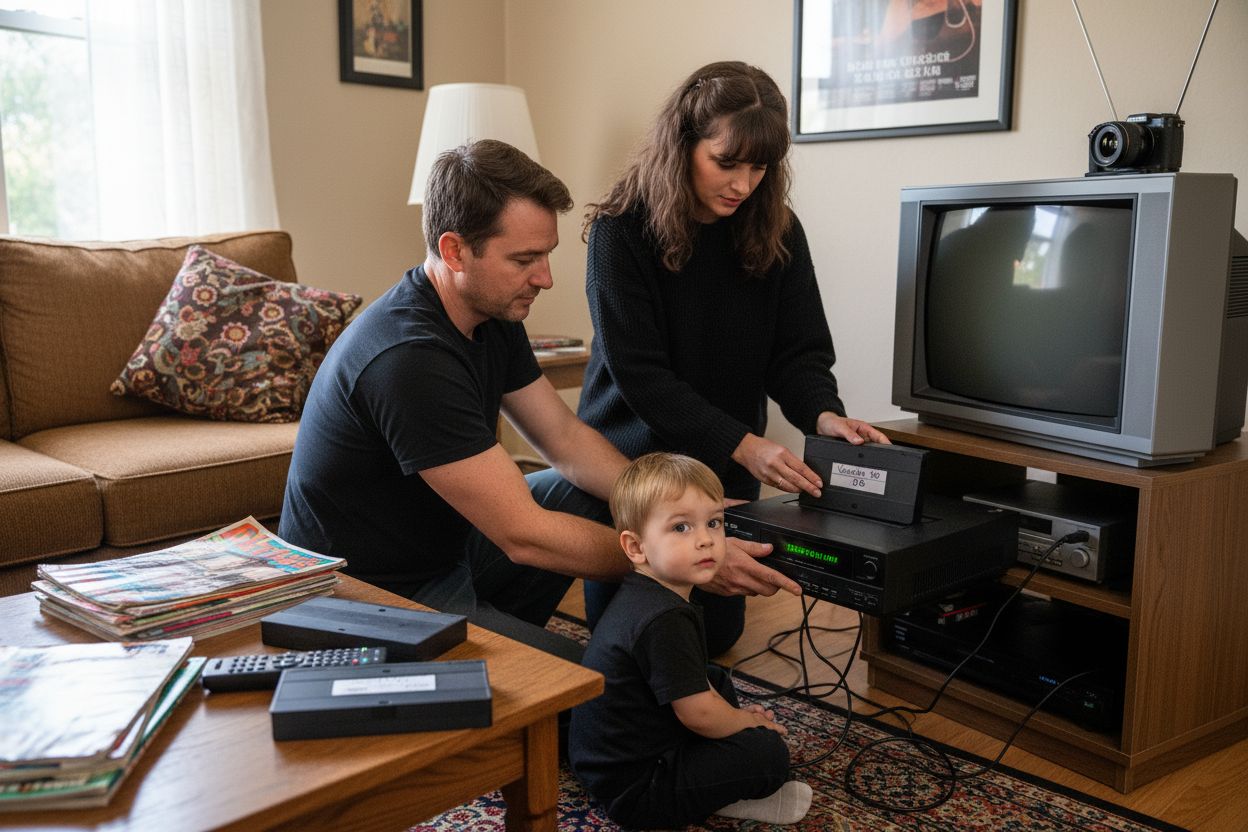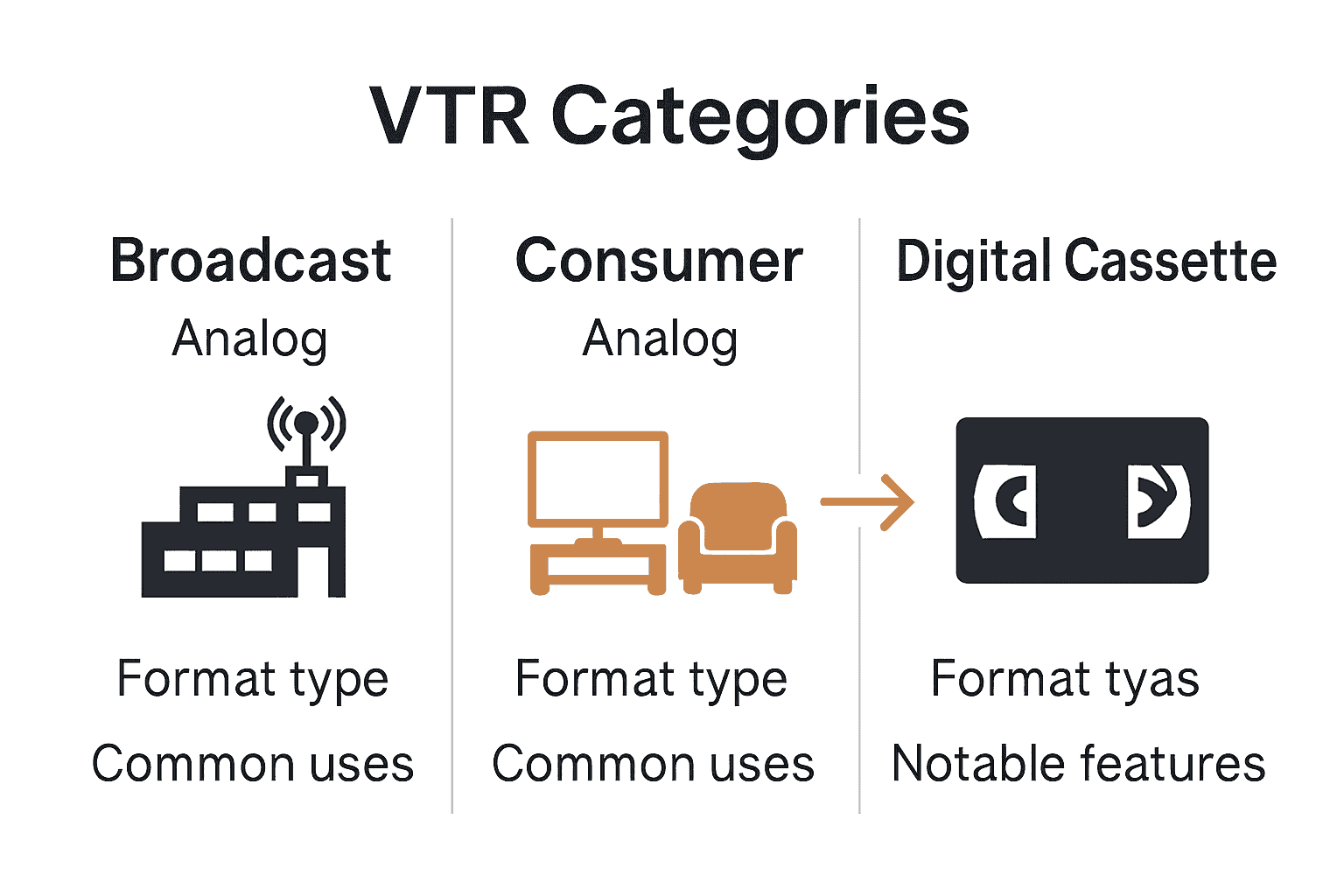Complete Guide to Video Tape Recorders
Comprehensive guide to video tape recorders: definition, types, how they work, key features, real-world uses, and digital alternatives explained.
Devdeep
Author
Complete Guide to Video Tape Recorders

Did you know that over 90 percent of television content before 1976 was never saved, largely because early recording technology was so limited? The video tape recorder changed that reality, making it possible to capture and replay moments that would have otherwise disappeared. Understanding how these machines work and why they mattered reveals the roots of home entertainment and modern video preservation.
Key Takeaways
| Point | Details |
|---|---|
| Video Tape Recorders (VTR) | VTRs revolutionized audiovisual content by enabling recording and playback on magnetic tape, marking a shift in media accessibility for consumers and professionals alike. |
| Technological Evolution | The transition from large, complex devices to user-friendly formats like VCRs democratized media creation and spurred personal video production. |
| Preservation Challenges | Magnetic tapes are susceptible to degradation, necessitating careful preservation strategies to ensure the longevity of recorded content. |
| Digital Alternatives | Digital formats provide a reliable solution for content preservation, offering improved accessibility and protection against deterioration compared to physical tapes. |
Table of Contents
What Is a Video Tape Recorder?
- What Is A Video Tape Recorder?
- Types Of Video Tape Recorders Explained
- How Video Tape Recorders Work
- Key Features And Common Uses
- Modern Risks And Digital Alternatives
A video tape recorder (VTR) is a groundbreaking electromechanical device that revolutionized how we capture, store, and replay audiovisual content. According to Britannica, these remarkable machines record and reproduce electronic signals containing both audio and video information directly onto magnetic tape, transforming how media was created and consumed.
Two primary technological approaches emerged in VTR design. The first, known as the transverse (quad) system, uses rotating heads positioned perpendicular to the tape path - ideal for high-quality broadcast recording with exceptional visual precision. The second approach, the helical system, records information diagonally around a rotating drum, making it perfect for home video and amateur recording applications. Wikipedia notes that these systems underwent significant standardization, which helped create a robust consumer market.
The evolution of VTRs tells a fascinating technological story. Early models were large, open-reel devices primarily used in television studios, requiring significant technical expertise to operate. Around 1969, videocassette recorders (VCRs) emerged, introducing enclosed cassettes that made recording and playback dramatically more accessible to everyday consumers. These innovations transformed how people experienced media:

- Allowed home recording of television programs
- Enabled personal video production
- Created new opportunities for content preservation
- Democratized media creation beyond professional studios
These devices weren't just technological products - they were gateways to new forms of personal and professional communication, bridging the gap between professional media production and individual creativity.
Types of Video Tape Recorders Explained
Video tape recorders have evolved through multiple fascinating formats, each representing a significant technological leap in audiovisual recording. Wikipedia outlines several critical categories that transformed how we capture and preserve visual media, spanning professional broadcast and consumer entertainment markets.
Professional Broadcast Formats
In the professional realm, analog open-reel formats dominated early television production. These included landmark technologies like:
Consumer and Home Video Formats
- 2" quadruplex systems (first professional video recording format)
- 1" Type C formats (standard for broadcast studios)
- High-resolution professional recording systems capable of broadcast-quality reproduction
Consumer video tape recorders brought recording technology into living rooms, with several competing formats emerging. These included:
Digital Transition Era
- VHS: The most popular consumer format globally
- Betamax: Sony's groundbreaking but ultimately less successful format
- Video8 and Hi8: Compact formats popular for camcorders
- Each format represented different technological approaches to compact, accessible video recording
As technology progressed, digital cassette formats emerged, offering dramatically improved video quality and storage capabilities. These digital formats included:
- Standard-definition digital cassettes
- High-definition digital formats like D-1 through HDCAM-SR
- Progressively smaller and more sophisticated recording technologies
Each format represented not just a technical innovation, but a step towards making video recording more accessible, portable, and high-quality for professionals and consumers alike.

Here's a comparison of major video tape recorder formats and their key characteristics:
| Format Type | Example Formats | Typical Use | Notable Features |
|---|---|---|---|
| Broadcast (Analog) | 2" Quadruplex<br>1" Type C | Professional TV studios | Large reels<br>High-quality recording |
| Consumer (Analog) | VHS<br>Betamax<br>Video8/Hi8 | Home entertainment<br>Camcorders | Compact cassettes<br>User-friendly<br>Affordable |
| Digital Cassette | D-1<br>HDCAM-SR | Broadcast<br>Archival | High-definition<br>Improved reliability |
How Video Tape Recorders Work
Video tape recorders transform electronic signals into magnetic recordings through ingenious mechanical and electronic processes. According to Britannica, these devices use two primary scanning techniques to capture and preserve audiovisual information: transverse-scan and helical-scan systems, each with unique approaches to recording media.
Transverse-Scan Recording
In the transverse-scan method, multiple recording heads mounted on a rotating drum write video information directly across the tape, positioned perpendicular to the tape's motion. This technique allows for high-precision recording, particularly in professional broadcast environments. The complex mechanism ensures that each pass captures a precise segment of visual information with exceptional clarity.
Helical-Scan Recording
Britannica's Kids Encyclopedia reveals fascinating details about helical-scan recording. In this method, rotating heads record diagonal strips across the magnetic tape, with the recording drum spinning approximately 30 times per second. The tape wraps around the drum at a specific angle, creating an innovative recording approach that enables:
Signal Conversion Process
- Interlaced video recording
- Freeze-frame capabilities
- Slow-motion playback
- Fast-forward functionality
- Timer-based recordings
The core magic of video tape recorders lies in their ability to convert electronic signals into magnetic patterns. As the rotating heads move across the magnetic tape, they create microscopic magnetic alignments that represent video and audio information. When played back, these magnetic patterns are converted back into electronic signals, reconstructing the original audiovisual content with remarkable precision.
This technological marvel transformed how we capture, store, and replay visual memories, bridging the gap between live moments and preserved experiences.
Key Features and Common Uses
Video tape recorders revolutionized personal and professional media interaction through a remarkable array of innovative features. According to Britannica, videocassette recorders (VCRs) became household staples during the 1970s and 1980s, offering unprecedented control over television consumption and recording.
Home Entertainment Features
VCRs transformed how people experienced media with groundbreaking capabilities:
Professional and Creative Applications
- Record television programs for later viewing
- Pause and resume live broadcasts
- Fast-forward and rewind recorded content
- Program automatic recordings via timer settings
- Watch one channel while recording another
Wikipedia highlights the Portapak as a pivotal innovation, introducing portable video recording in 1967. This battery-powered system enabled:
Technological Impact
- One-person video recording outside studio environments
- Documenting news and cultural events
- Creating independent documentaries
- Capturing personal and home movie experiences
These devices weren't just recording tools - they were gateways to democratizing media creation. By making video recording accessible and affordable, video tape recorders empowered individuals to become storytellers, preserving memories and capturing moments that would have otherwise been lost.
Read more about modern video recording technologies and how they've evolved from these groundbreaking tape-based systems.
Modern Risks and Digital Alternatives
Video tape recordings face significant preservation challenges that threaten the longevity of cherished memories and historical documentation. According to the Council of Library and Information Resources, magnetic videotapes are inherently vulnerable to multiple forms of degradation that can result in permanent data loss.
Physical and Environmental Risks
Magnetic videotapes deteriorate through several critical mechanisms:
Preservation Strategies
- Substrate deformation: Physical warping of tape materials
- Binder breakdown: Chemical breakdown of magnetic recording layers
- Vinegar syndrome: A destructive chemical process causing tape brittleness
- Environmental factors like humidity and temperature accelerate degradation
The Canadian Conservation Institute emphasizes that preservation requires a multifaceted approach:
Digital Migration
- Protect physical media from environmental damage
- Maintain functional playback equipment
- Digitally migrate content before irreversible degradation
- Store in controlled temperature and humidity environments
Digital alternatives offer a robust solution to the fragility of magnetic tape. Modern digital formats provide:
- Lossless content reproduction
- Easier storage and accessibility
- Protection against physical media deterioration
- Simple sharing and distribution
Learn about modern video recording technologies that have revolutionized how we preserve and share visual memories.
Ready to Move Beyond Video Tape Recorders? Experience the Future With Boom
If reading about video tape recorders has reminded you how fragile and outdated traditional recording methods can be, you are not alone. The article revealed how magnetic tapes risk physical degradation and require special equipment that is rapidly becoming obsolete. You want to preserve and share video content without worrying about lost memories, clunky devices, or complicated processes. You deserve a solution that is fast, secure, and designed for today’s world.

Say goodbye to the hassle of storing and maintaining old equipment. Step into the era of AI-powered asynchronous video with Boom—your tool for creating, recording, and sharing polished videos effortlessly. With features such as voice-to-video recording, instant scripting, multilingual voiceovers, and brand-ready templates, Boom protects your time and gives you everything needed to make stunning videos entirely online. Do not wait until your memories fade or your message gets lost. Try Boom today at https://boomshare.ai and see how easy it is to start recording smarter, not harder. For more on how modern tech can transform your workflow, check out understanding features of modern video tools.
Frequently Asked Questions
What is a video tape recorder and how does it work?
A video tape recorder (VTR) is an electromechanical device that records and reproduces audiovisual content onto magnetic tape. It works by converting electronic signals into magnetic patterns using scanning techniques like transverse-scan and helical-scan.
What are the different types of video tape recorders?
Video tape recorders come in several formats, including professional broadcast formats like 2" quadruplex and 1" Type C, consumer formats like VHS and Betamax, and digital formats such as D-1 and HDCAM-SR, each serving specific recording needs.
What are the key features of video tape recorders for home use?
Home video tape recorders, such as VCRs, offer features like the ability to record television programs, pause live broadcasts, fast-forward and rewind recorded content, and program automatic recordings, significantly enhancing media consumption at home.
What are the risks associated with preserving video tape recordings?
Video tape recordings face risks like physical warping, chemical breakdown, and environmental damage that can lead to data loss. Preservation strategies include digitizing content, storing tapes in controlled environments, and maintaining functional playback equipment.
Recommended
About the Author
Devdeep
Senior Software Engineer.
